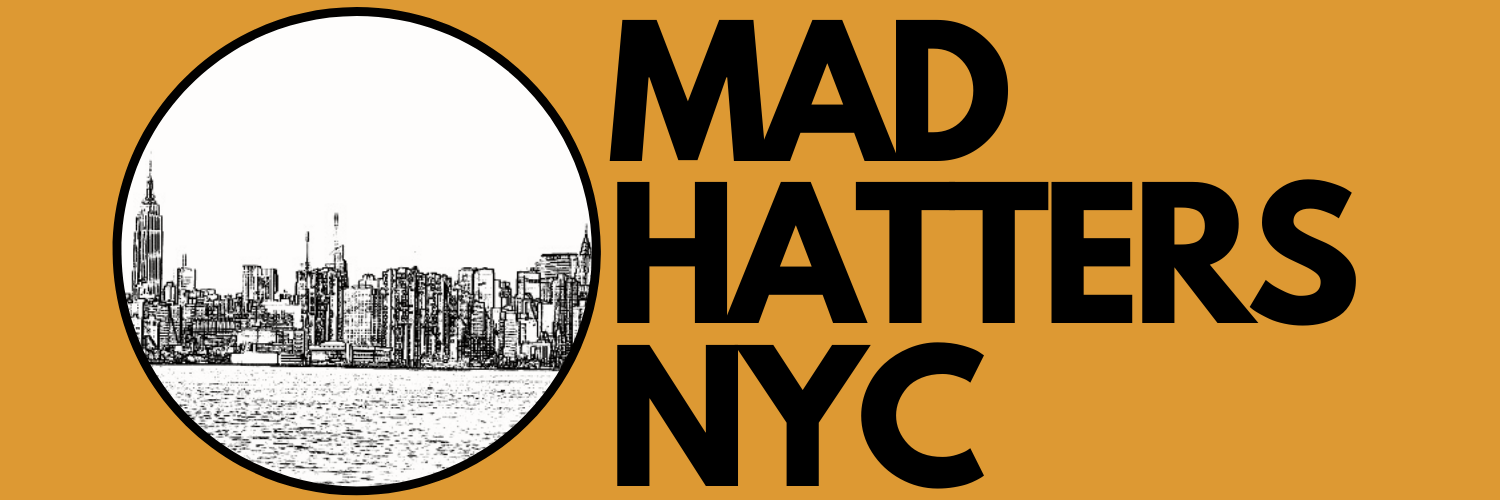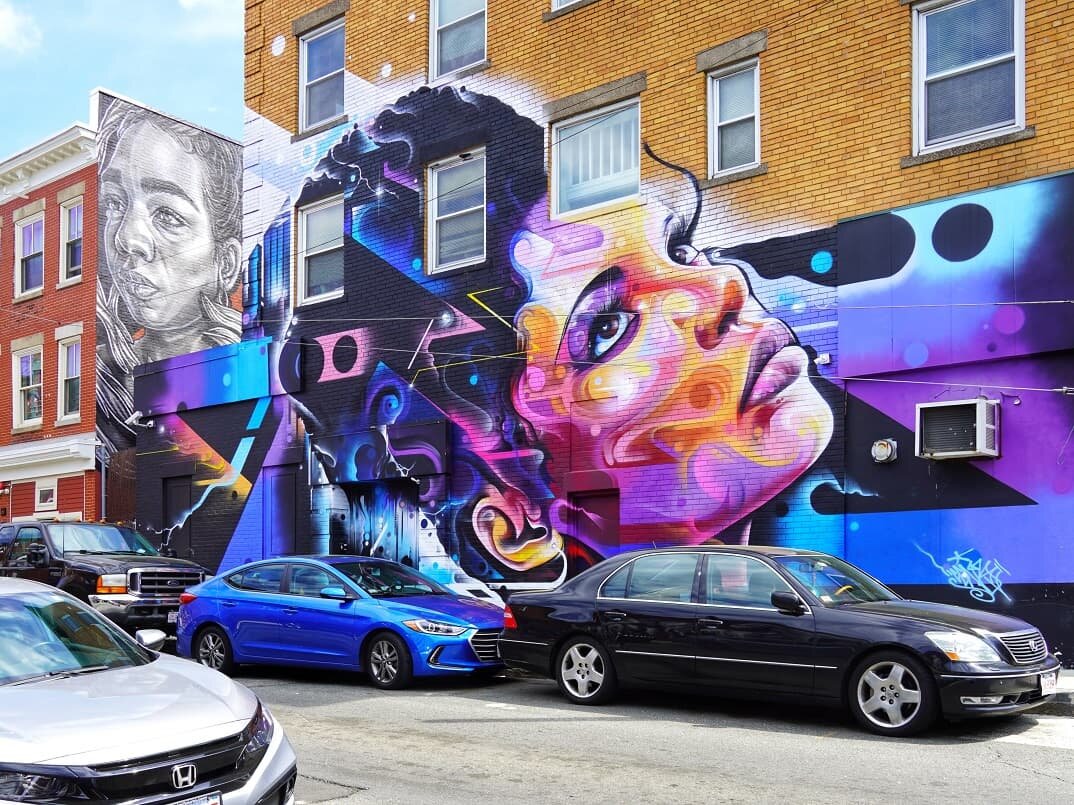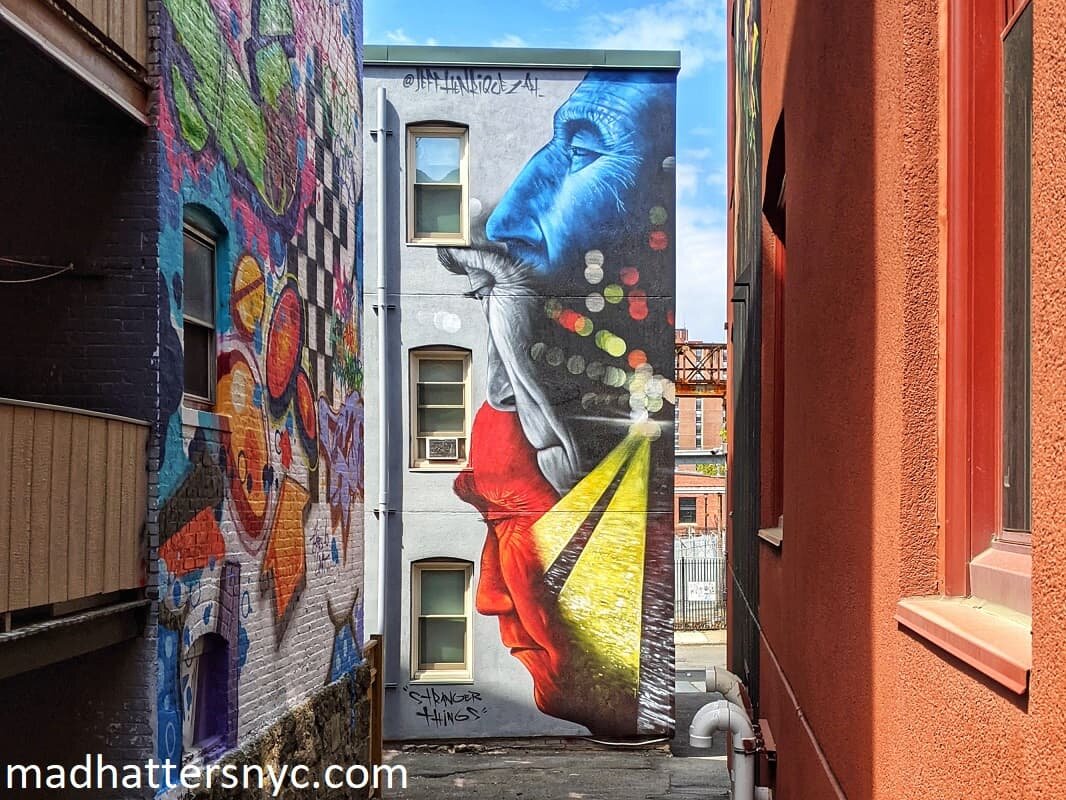Salem's Best-Kept Secret: The Spellbinding Street Art of the Punto Urban Art Museum
Although graffiti was once considered a neighborhood scourge, it’s a true testament to the talents of graffiti and mural artists that street art is now one of the many tools employed in city revitalization and beautification programs. It’s a model that works, so it’s no surprise Salem, Massachusetts ventured down the same path. What’s unique about Salem’s foray into urban art is how it became a source of pride for the Latino community.
Where is the Point?
Stranger Things by Jeff Henriquez
The Point, or El Punto, is a neighborhood just south of downtown Salem, not even a 10-minute walk from the Salem Visitor Center. Previously occupied by French Canadians who worked in nearby mills, the neighborhood is now majority non-white, with a large community of immigrants from the Dominican Republic and Haiti.
As with many immigrant neighborhoods, an invisible border exists. Even though Salem is a bustling travel destination, inhabitants of The Point were not reaping the same social and economic opportunities from its robust tourism industry. It is the densest neighborhood in Salem, with approximately 4 times as many people per acre than the rest of the city. And even though it has a lower crime per capita ratio, crimes in The Point are often highlighted in the news. So in 2013, the City of Salem, the North Shore Community Development Coalition (NSCDC), and the Metropolitan Area Planning Council (MAPC) came together with an action plan to address some of the disparities. The plan ranged from improving infrastructure to creating job placement programs. To increase neighborhood pride and civic engagement, the Punto Urban Art Museum was born.
What is the Punto Urban Art Museum?
Garden Boy by Pixel Pancho
The North Shore CDC doesn’t simply maintain affordable housing and serve low-income communities, it also hosts a robust art program. But when launching the Punto Urban Art Museum, it had a secret weapon. Renowned street artist Ruben Ubiera once called The Point home, and his sister worked as the North Shore CDC’s Chief Programs Officer. So Ubiera was one of the first to sign up as a contributing artist, and he brought his influential street artist friends with him.
Its first set of murals were painted in the summer of 2017, and the Punto Urban Art Museum officially launched that fall. More street artists returned to add to the already impressive collection, and now 75 murals make up the spectacular open-air art museum covering a 3-block radius.
When we were wandering around the Greenmount West neighborhood exploring the amazing street art of Baltimore, a homeowner approached us. Worried that our rabid picture-taking was unwelcome, we were ready to apologize and take our leave. But instead she asked, “Do you know how I can get one of these murals on my house?” Similarly, at The Point, it’s easy to see the community is proud to display the many works of art on their homes. Though currently on hold due to COVID restrictions, North Shore CDC organizes street art tours through the Punto Urban Art Museum. It has transformed The Point into a destination for locals and visitors alike.
Hispanic and Latino Street Artists You Need to Know
The Punto Urban Art Museum curators have taken painstaking care to include a variety of international and local talents, including 25 street artists who call New England home. Many murals speak to issues that affect immigrant populations. Migrar, or Migration, by Colombian artists Felipe Ortiz and Ivan Salazar, and Queen of the Block by Mr. Cenz are among the murals that allow members of the community to see themselves reflected on the walls around them. Pride + Identity by Spanish graffiti team Boa Mistura enforces a simple, yet effective, message. And the portrait of Puerto Rican astrologer Walter Mercado by JEKS captures a beloved Latino idol.
But the museum’s mission of inclusion and community building resonated with many Hispanic and Latino artists, creating a veritable who’s who list from its roster. Here are a few street artists to know.
Ruben Ubiera
Anacaona by Ruben Ubiera
Instagram: @urbanruben
We first became acquainted with Ruben Ubiera through the Bushwick Collective, a Brooklyn street art gallery where Ubiera is a returning artist. His large-scale murals like Deconstructed Biggie and It Was All a Dream have been some of Bushwick’s biggest draws over the years. Living in South Florida, his work is perpetually featured at Art Basel and Wynwood Walls, Miami’s premier street art destination. He has also completed several successful commercial campaigns.
Ubiera has contributed two significant murals to the Punto Urban Art Museum. One of them is of Anacaona, a Taino ruler, poet and oral historian. The Taino is a an indigenous tribe of the Dominican Republic and Haiti, though Ubiera's portrait of the revered leader closely resembles his sister.
Antonyo Marest
Villa Allegra by Antonyo Marest
Instagram: @antonyomarest
Antonyo Martinez Esteban, who uses the name Antonyo Marest commercially, is from Alicante, Spain. His unique pop art brand combines his study of architecture with his contagious optimism. Combining bursts of color with geometric shapes, he routinely transforms buildings into stunning works that leap off the sidewalk, altering a street’s façade permanently.
In Salem’s Point neighborhood, he converted one of the North Shore CDC’s mixed-use properties with 10 affordable housing units into Villa Allegra. Antonyo Marest has other creations bearing similarly cheerful monikers, like his Allegra Pavilion in Kolkata, India. It’s a building most of us would be happy to call home.
Sipros Naberezny
Super Dali by Sipros Neberezny
Instagram: @sipros_sipros
Sipros Neberezny is a Brazilian artist whose unmistakable big-eared portraits of children, friends (including fellow street artists!) and celebrities are known around the world. His murals always capture a combination of humor and childlike wonder.
His Super Dali mural for Punto Urban Art Museum captures one his favorite muses, surrealist Salvador Dali, in a mask and cape against a bright pink background.
Bik Ismo
Le Quedo Bufeaito by Don Rimx and Chrome Dog by Bik Ismo
Instagram: @bikismo
Joshua Santos Rivera, better known as Bik Ismo, was born and raised in Arecibo, Puerto Rico. His unmistakable signature has earned him the title of “Chrome Master”, as his murals are 2D renderings of 3D shapes which manage to capture the reflective properties of chromium plate perfectly. He raised the profile of street art in Puerto Rico by organizing large urban art events and bringing the first exhibition of graffiti on canvas to his home country.
For the Punto Urban Art Museum, Rivera’s Chrome Dog is a 3-story tall gleaming French Bulldog that watches over the residents of the neighborhood.
Don Rimx
Instagram: @donrimx
David “Don Rimx” Sepulveda was born and raised in San Juan, Puerto Rico. Sepulveda was raised in public housing, so he’s dedicated much of his career to community redevelopment efforts. From decorating fences in Israel to parking garages in Utah, his murals help build local pride.
Salem’s efforts to close the socioeconomic gap between The Point and the rest of the city is a cause that aligns squarely with Sepulveda’s purpose. His Le Quedo Bufeaito mural is located next to fellow Puerto Rican Bik Ismo’s. His usual wood and brick elements can be fully appreciated in this oversized street art piece.
CPWON
Instagram: @cpwon
Claudio Picasso was born in Chile and raised in Miami. He’s a student of the arts, covering a range of disciplines from sculpture to printmaking to digital art. Picasso is a fan of hyperrealism, and he often prefers to work in monochromatic themes to highlight the details of his subjects. Italian marble sculptures are some of his favorite subjects, and they seemingly come alive with the shading techniques he employs.
A vacant lot tucked behind 100 Lafayette Street features several of the outdoor museum’s notable murals, accessible through an alley just south of the North Shore CDC’s offices. Though alleys are normally designed to disappear into their environs, this one isn’t easy to miss. Anyone looking south on Lafayette will catch a glimpse of a Picasso’s haunting pair of eyes peeking out from it.
Curiot
Instagram: @curiotli
Favio Martinez was born in central Mexico, in the historical UNESCO World Heritage City of Morelia. His strong ties to home have kept him in Mexico, though he now resides in the Mayan Riviera. His heritage influences his work heavily, with references to animals, characters and scenes from Mexican folklore. Bright colors are also a distinguishing feature of his intricate murals.
His untitled work covers the entrance façade of Salem’s Seagrass Dispensary, converting the wall into a mesmerizing swirl of pattern of color.
How Does Punto Urban Art Museum Support Local Artists?
According to Yinette Guzman, North Shore CDC’s Design & Placemaking Project Manager, promoting local artists is yet another one of the Punto Urban Art Museum’s lofty goals. In September 2020, the museum invited 20 Massachusetts-based artists to convey their interpretation of freedom through art, which attracted a diverse pool of talent. In addition to developing an outlet for local voices and encouraging dialogue on important issues, Punto Urban Art Museum awarded each artist $1,000 for their efforts. A new exhibit will be installed in the fall, allowing the museum to showcase and nurture even more New England creators.
Conclusion
Salem has both the fortune and misfortune for being known as a popular Halloween destination. In an effort to give it due credit, our Salem travel guide highlights why it’s an attractive year-round destination. The Punto Urban Art Museum is another notch in this charming New England city’s belt, which will continue to grow and evolve as new murals are added. Don’t miss the opportunity to explore this masterful fusion of culture and community on your next visit.











